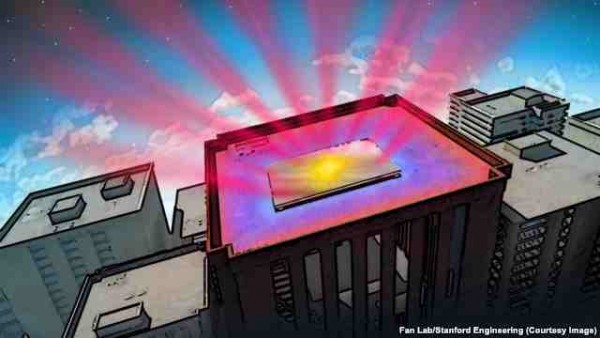New Cooling Technology Transfers Heat from Buildings into Space
| Kizha T. Trovillas | | Nov 27, 2014 03:24 AM EST |
(Photo : Fan Lab, Stanford Engineering) The internal structure of this material is designed to radiate heat at an exact frequency to pass safely into space.
Stanford University engineers have invented a new technology that radiates heat away from buildings and sends it directly into space without using electricity.
The revolutionary technology, which can help cool buildings even in sunny days, is an ultrathin, multilayered material that could be installed on a roof like solar panels. But unlike solar panels, the new material turns heat into visible light and beams it away as infrared radiation.
Like Us on Facebook
Interestingly, the infrared radiation is transmitted by the new material through the atmosphere into space without even warming the atmosphere at it passes.
The material consists of seven layers of silicon dioxide and hafnium oxide above a thin layer of silver. The internal structure of this material is designed to radiate heat at an exact frequency to pass safely into space.
It acts like a high-tech mirror that can both siphon heat out of the buildings and reflect the sun's rays, and can sends both into the coldness of space.
Stanford University electrical engineering professor Shanhui Fan described the latest invention as a structure that cools itself without electricity input.
Fan added that since the material basically radiates heat to outer space and reflects sunlight, it can't get heated by the sun. The net result is a significant decrease of temperature, even below ambient air temperature.
In tests, the material showed a cooling rate of around 15 percent, which means it can reduce indoor temperature to nearly 5 degrees Celsius below the outside temperature.
Stanford engineers noted that one possible use of the new cooling technology would be in buildings with limited access to electricity or air conditioning in developing countries. More broadly, engineers see the project as a first step toward using the cold of space as a resource.
"This is very novel and an extraordinarily simple idea," said noted engineering professor Eli Yablonovitch from Berkeley's University of California, who also directs the Center for Energy Efficient Electronics Science.
©2015 Chinatopix All rights reserved. Do not reproduce without permission
EDITOR'S PICKS
-

Did the Trump administration just announce plans for a trade war with ‘hostile’ China and Russia?
-

US Senate passes Taiwan travel bill slammed by China
-

As Yan Sihong’s family grieves, here are other Chinese students who went missing abroad. Some have never been found
-

Beijing blasts Western critics who ‘smear China’ with the term sharp power
-

China Envoy Seeks to Defuse Tensions With U.S. as a Trade War Brews
-

Singapore's Deputy PM Provides Bitcoin Vote of Confidence Amid China's Blanket Bans
-

China warns investors over risks in overseas virtual currency trading
-

Chinese government most trustworthy: survey
-

Kashima Antlers On Course For Back-To-Back Titles
MOST POPULAR
LATEST NEWS
Zhou Yongkang: China's Former Security Chief Sentenced to Life in Prison

China's former Chief of the Ministry of Public Security, Zhou Yongkang, has been given a life sentence after he was found guilty of abusing his office, bribery and deliberately ... Full Article
TRENDING STORY

China Pork Prices Expected to Stabilize As The Supplies Recover

Elephone P9000 Smartphone is now on Sale on Amazon India

There's a Big Chance Cliffhangers Won't Still Be Resolved When Grey's Anatomy Season 13 Returns

Supreme Court Ruled on Samsung vs Apple Dispute for Patent Infringement

Microsoft Surface Pro 5 Rumors and Release Date: What is the Latest?










